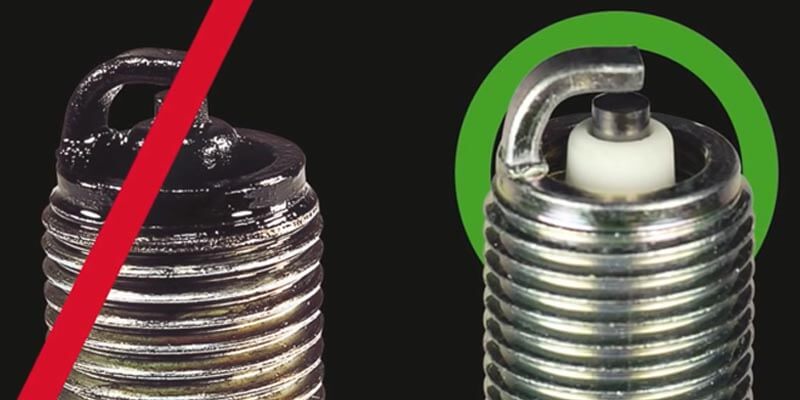You are almost late for your work. To make things worse, now your car is not starting. Even if it starts, the engine is behaving unusually. Maybe it’s a flat battery? Or maybe the fuel is low?
Well, we often overlook the actual problem. Spark plugs are the unsung hero of your vehicles. They ignite the engine so it can produce power. Here we are, with a step-by-step guide on how to un-foul a spark plug.
How to Un-foul a Spark Plug – Step by Step Guide
Estimated Cost – Around 100 dollars
Time Needed – Around 40 minutes
Now that we know how much you’ll have to spend, let’s look at what tools and materials you require to successfully un-foul the spark plug and breathe new life into your engine.
Tools you may need –
- Trigger start torch
- Wire brush
- Air blower of any kind
- Vice
- Pneumatic spark plug cleaner (optional)
- Brake cleaner (optional)
Step 1 – Take Out and Prepare the Spark Plug
The very first thing you’ll have to do is to take out the spark plug. Once you locate it, gently remove it using your hands or a wrench.
Rotate the spark plug counterclockwise until it comes off. If you want to clean spark plugs without removing them from the engine, well, sorry, that’s not going to work well;
After taking the spark plug out, you must inspect it before un-fouling it. You have to be sure that it’s salvageable. Don’t waste time cleaning it when it’s too late for the spark plug to survive. Getting a new one is a much easier solution to your problem.
Related: What Is A Spark Plug Non-Fouler?
Anyway, back to the point.
Now place the spark plug into the vice. You can use other ways to hold the spark plug for torching. Using a vice is recommended, but it’s not something you MUST need. Just make sure that the environment and whatever’s holding your spark plug can withstand high heat.
Place the spark plug in such a way that there’s no chance of it moving while torching. It should stay firm and steady.
Step 2 – Torching the Spark Plug
Now the fun part begins. Once you securely hold the spark plug into the vice, all you got to do is torch it until it turns red or orange. Don’t worry; the high temperature won’t damage the spark plug.
Using a butane torch ensures the best result. Follow the instruction manual to carefully ignite the torch. Igniting a torch can be risky for many people, so make sure you know what you do.
Once the torch is up and running, point it towards the spark plug held by the vice. As we said earlier, heat the spark plug until it becomes burning red.
The torching could go on for like 5 to 10 minutes. Yes, you have to continually heat the plug for 10 minutes, depending on how hot your torch can burn.
It is important to heat only the upper portion of the spark plug. The portion where it looks burnt black is where your torch is supposed to heat up. Also, keep the torch about 5 inches away from the plug. Not too close, not too far.
After you are done torching the spark plug up thoroughly, you have to let it cool down for 20 minutes. Do not touch it immediately though. The plug will remain super-hot for a long time, so the longer you wait, the safer. 20 minutes is the minimum.
Step 3 – Clean the Spark Plug
When you are sure that the spark plug has cooled down and is safe to touch, take out a wire brush and scrape out all the residue. One thing you’ll notice here; the plug is becoming brownish.
Make sure to scrape off all the residue deep inside the spark plug. Rub the wire brush all over the plug for a few minutes. You can also use any pointy metal object, such as a screwdriver.
If you are doing the scraping well enough, soon you’ll see that the shiny metal parts are a lot more visible, and the black/brown colors are fading away.
Step 4 – Blowing Off All the Residue
Now blow out all the remaining residue using an air blower.
Point the air blower near the top of the spark plug and give it all you got. Make sure you don’t leave out any spots. An air blower with a small or very narrow opening will be the best for the job as the spark plug is also very small.
After this, your spark plug should be all ready to roll out and ignite your precious engine like before. Follow step five if you want a less costly way of cleaning out your spark plug. Do remember that it’s also less efficient.
Step 5 – Using An All-in-One Cleaner
First off, you need to get a spark plug cleaner. Once you have it, connect the cleaner to a pneumatic air compressor and set the right pressure.
At the opposite end of the air compressor intake, there’s a hole that your spark plug will go in. Before that, place the cleaner so that the cloth pouch is at the top. This way, all the grit will fall.
Now press the button next to the air intake, insert the plug, and slowly move it in a circular pattern so that the grit hits every corner of the plug. You can even rotate the plug sometimes. Do this for a minute or two and pull out the plug afterward.
After the gritting process, you MUST clean off all the remaining grit before using the spark plug. Anything that remains in the plug will enter your cylinders, so clean it thoroughly. Use a wire brush to scrape and an air blower to blow away the grit. You can even use a cleaning solvent. We use brake cleaner.
This process sometimes requires heating up with a torch anyways, so we prefer not to use the cleaner. It costs less, yes, but it’s also less efficient.
What Causes Spark Plugs to Get Fouled
Repairing/cleaning/un-fouling is fascinating, but what’s even more fascinating is getting to know why your spark plug gets fouled in the first place. Here’s why the spark plug gets fouled.
Combustion Byproducts Build-up
The most common cause for spark plugs to go bad is combustion build-up. Yes, these plugs are coated with protective coatings, but no one said they’ll last forever.
Due to different gasses and oil build-up, the spark plug may foul. This oil and gas build-up will contaminate the plug and prevent it from functioning the way it should.
Bad Spark Plugs Wires
Bad or damaged spark plug wires can also cause the spark plug to not work properly. The wires might be cross-firing when they are wet.
To check this, open the hood, and wet the wires. Now start the engine, and see if the sparks are jumping from the metal or the wires to each other. If so, you need to replace the wires.
Leaking Head Gasket
A head gasket leaking oil or coolant into the cylinder can contaminate the spark plug and cause it to get fouled. So always check if the head gasket fits snuggly and if there aren’t any leaks or cracks.
Conclusion
You might be wondering, instead of going through all these hassles, why not just replace spark plugs every time they get fouled? That’s logical to think as the plugs don’t cost that much.
There can be different reasons for the car not to run correctly. It takes time to pinpoint the exact cause. Buying a new spark plug every time it gets fouled until you find out the problem will be very expensive, and it’s not practical either.
This is why you need to know how to un-foul a spark plug and save yourself some bucks. So, can you reuse spark plugs? This guide should clear your confusion and help you un-foul and reuse old spark plugs.

